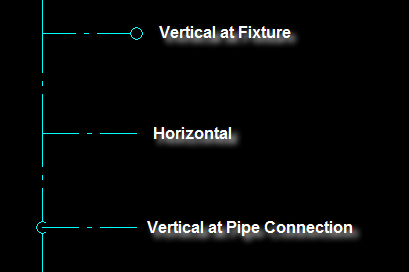Connecting a fixture to a pipe seems like it should be a simple one-button command. However, what we have learned from our customers is that there are a lot of different types of fixture connections. The current version of Design Master Plumbing includes 15 different buttons for connecting a fixture to a pipe. They share some similarities, but they are all different.
There are three main types of connections that depend upon how the change in elevation between the fixture and main pipe is handled.
- Vertical at Fixture: A pipe is extended horizontally from the main pipe to the fixture, then goes up or down at the fixture.
- Horizontal: A pipe is extended horizontally to the fixture. The connection to the fixture is at the same elevation as the main pipe—there is no change in elevation.
- Vertical at Pipe Connection: A pipe goes up or down from the main pipe, then extends horizontally to the fixture.

Those three types determine the main appearance of the connection. There are five different ways using our software to decide where to connect on the main pipe.
- Direct 90 Connection: The connection point is located perpendicular to the fixture. Using this connection type, you can connect multiple fixtures at a time.
- Direct 45 Connection: The connection point is located such that the pipe extending to the fixture is 45-degrees from the main pipe. This connection type also supports connecting multiple fixtures at a time.
- 90-45: A pipe extends 90 degrees from the main pipe, then turns at a 45 degree angle and connects to the fixture. You have to select the location where the connection leaves the main pipe, so this connection type has to be done one fixture at a time.
- 45-90: A pipe extends 45 degrees from the main pipe, then turns 45 degrees to connect to the fixture (this second pipe will be perpendicular or parallel to the main pipe, depending upon where the first pipe connects). This connection type also requires fixtures to be connected one at a time.
- End: A pipe extends directly from the end of the selected pipe to the fixture. No extra turns or pipes are inserted.
This video demonstrates these five methods of connecting fixtures. The final result for all five is similar—the difference is in how you get there.
A common misuse of the 45-90 connection type is for connecting waste fixtures where a 45-degree fitting is desired at the tee. While you can use this connection type, it is a lot more work that necessary. Instead, you want to set up the pipe type to have 45-degree fittings and use the “Direct 90 Connection” option. The little 45-degree fitting will be inserted automatically for you.
Combining the three main types of connections with the five different ways of choosing the connection point gives you 15 total fixture connection commands. That is a lot of ways to connect a fixture!
